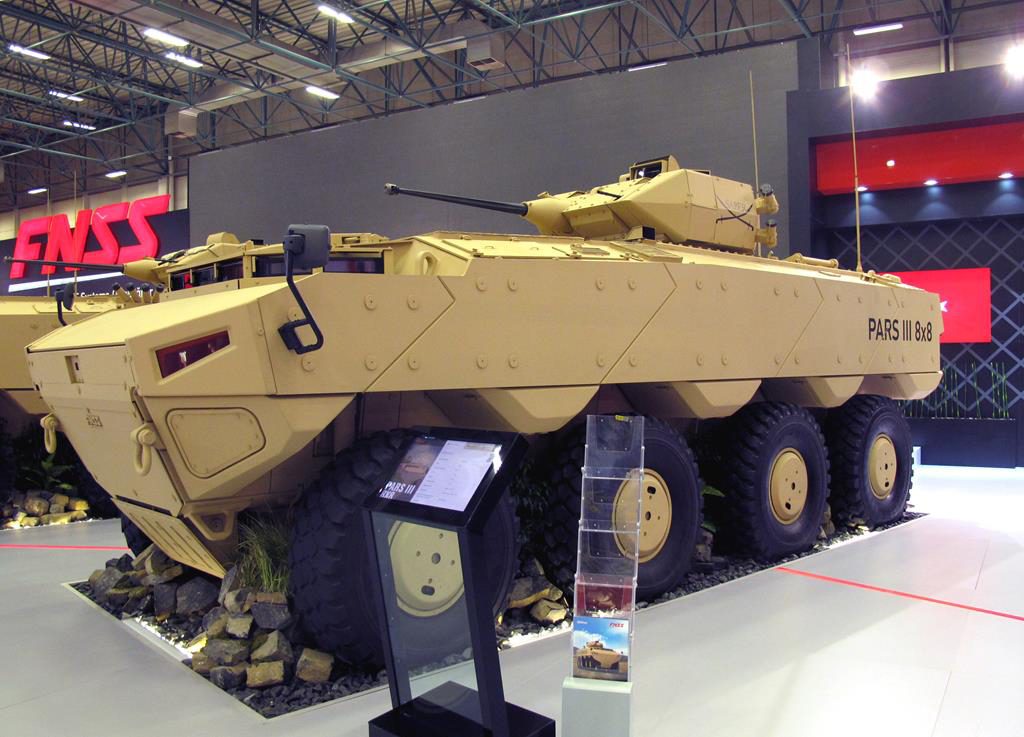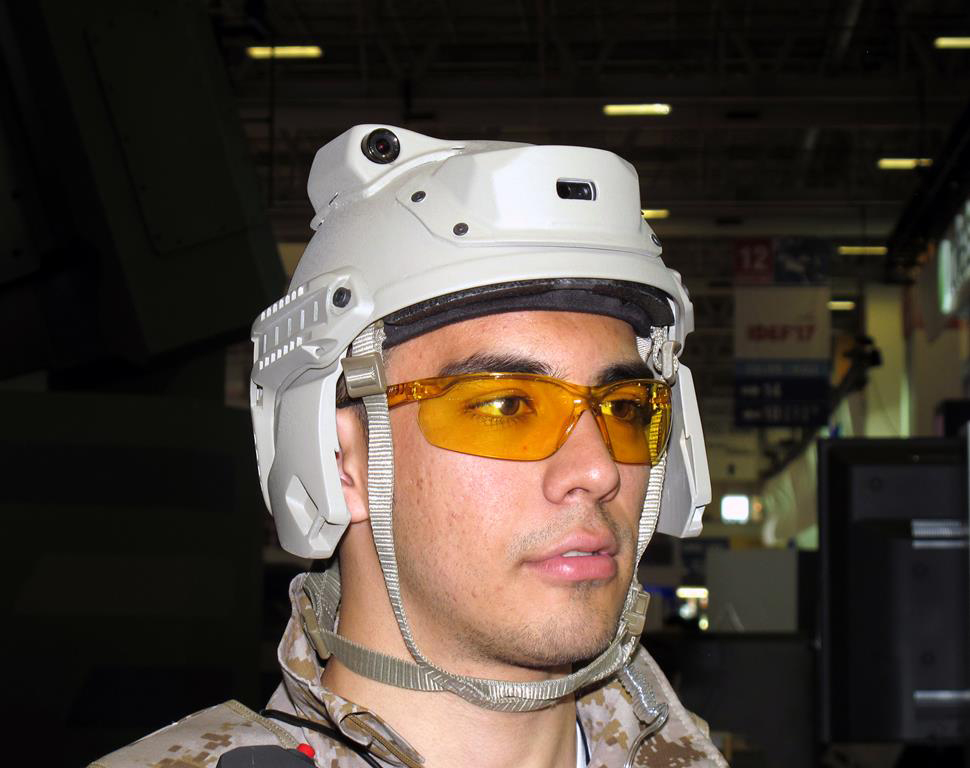IDEF 2017: the Turkish industry showcase
By Paolo Valpolini
Inaugurated on May 9th by Turkish Prime Minister Binali Yildirim, the 13th edition of IDEF gathered around 800 exhibitors, equally split between national and international companies. The Turkish exhibition shows well the nation’s will to become as much independent as possible in the defence field, foreign companies looking mostly to cooperation programmes with the local industry.

While the land domain was definitely the one most represented at the Istanbul event, aviation and naval subjects were also at the forefront. On 28 January 2017 in Ankara, in the presence of the Prime Ministers of Turkey and the United Kingdom, BAE Systems and Turkish Aerospace Industries (TAI) signed a Heads of Agreement to collaborate on the first development phase of an indigenous fifth-generation fighter jet for the Turkish Air Force – TF-X. No comments were available from the British company at the Tüyap Exhibition Centre, however, in the propulsion domain Rolls-Royce, key partners in Eurojet Turbo, announced its joint venture with Kale. Other Eurofighter partners, such as Leonardo aim at being part of the TF-X team. The Istanbul exhibition was also the first for the two new air-to-air missiles, in development by Tübitak SAGE, the Defense Industries Research and Development Institute part of the Scientific and Technological Research Council of Turkey, and that will be initially deployed on Turkish Air Force F-16s, and then on the FT-X: the Gökdoğan (Peregrine) is an IR short range missile while the Bozdoğan (Merlin) is a radar guided longer range weapon. As for contracts, TAI announced the signature with SSM of a contract for the final development and serial production of the Hürkus-C light attack aircraft.

Coming to the naval sector, the model that attracted the most interest from visitors was definitely that of the new L-400 LHD Anaconda exhibited at the Turkish Associated International Shipyards (TAIS) stand, the consortium formed in 2017 that includes five major shipyards and aims at promoting the Turkish naval export. The cut-out of the ship, based on the Spanish Juan Carlos built by Navantia, was clearly showing the ship capabilities in terms of land and air assets, including the F-35B, six of which can be hosted on board. Last January the keel of the first Istanbul-class frigate was laid down; heavily based on the Ada-class anti-submarine/patrol corvette design, they will be nearly 14 meters longer with a displacement of around 3,000 tonnes, adding an MK.41 vertical launch system for the Evolved Sea Sparrow Missile. A further class of four air defence ship is expected to be produced as part of the MilGem project.

Lessons learned during operation Euphrates Shield in Syria are influencing some of the Turkish Land Forces (TLF) programmes, especially those related to MBT upgrade. While awaiting for the new Altay tank, the TLF are planning to upgrade some of the existing tanks, M60T, M60A3 and Leopard 2A4, in order to increase their survivability towards antitank missiles and rockets. On 11 May a contract was signed between SSM and Aselsan for the upgrading of M60T tanks; the prototype exhibited at IDEF included a SARP RCWS in place of the original cupola, a Laser Warning Receiver, a 360° situational awareness systems, improved air conditioning system and spall liners. A new Explosive Reactive Armour (ERA) package, aimed at replacing the one installed by Israel Military Industries, is under trial at Roketsan. Fort the time being no upgrade contracts for M60A3s and Leopard 2A4s have been filed, Aselsan and other Turkish companies have already made their proposals to SSM.

Coming to the Altay, the four prototypes have logged over 25,000 km, one of them more than 11,000 km on its own, and fired nearly 3,000 rounds of all types and in all possible situation. Most of the work was completed in late 2016, and only maintainability, recovery and electromagnetic compatibility tests were redone and ended last February, leading to the qualification and acceptance that will be formalised once technical data packages will be completed and delivered to SSM. Otokar exhibited the Altay AHT ( Harp for Asymmetrical Warfare Tank), fitted with torsion bar suspensions. The commander periscope has been replaced by an RCWS, while at the rear of the turret a mast-mounted optronic system provides full 360° situational awareness (SA). Protection is increased by the adoption of a new ERA the front area and up to half the side skirts, chassis and turret, the rear half being protected by a slat armour, a sot-kill system based on a turning platform with eight 76 mm grenade launchers interfaced with the laser warning system being also installed as well as an RC-IED multiband jammer and a small arms fire acoustic detection system. Finally, a dozer blade, controlled by the driver, has been installed at the front.

FNSS unveiled the prototype of the Kaplan MT (Medium Tank) developed in cooperation with PT Pintad of Indonesia. Exhibited beside the Kaplan 30, another first, it maintains the same 711 hp engine however in the tank this is located at the rear, the IFV having it at the front. Both feature a six-roadwheel chassis, torsion bar suspensions, transmission and final drives being identical. The chassis is fitted with a CMI Defence 3105 turret armed with a 105 mm full pressure gun equipped with an automatic loader. A second Kaplan MT is being built in Indonesia, the Army planning to show them on parade on 5 October, the national Armed Forces Day. A production contract for some 100 tanks is expected to be filed once the vehicle will be accepted, qualification tests starting in late 2017.

FNSS already bagged an export success for the latest version of its PARS wheeled vehicles, now at the PARS III standard, fitted with new hydropneumatic suspensions. These being all outside the chassis, the internal volume is considerably greater than previous PARS vehicles. Both the 6×6 and 8×8 versions are being manufactured for an undisclosed Gulf customer, the shipment of first vehicles being planned for August 2017. Another first at the FNSS stand was the PARS 6×6 İZCİ, a scout version developed to anticipate Turkish requirements for a vehicle with a superior situational awareness at the front, the windscreen adopted ensuring a 230° view to the front crew.

Remaining among wheeled vehicles, in front of the Otokar stand we could find the Al Jasoor stand, the JV between Tawazun and the Turkish company aimed at producing the Rabdan, the 8×8 selected by the UAE. A small batch of vehicles will be manufactured in Turkey, the JV aiming at starting as soon as possible the production locally, using kits provided by Otokar.

Some new vehicles were exhibited in the light armoured category, such as the 10 tonne NMS 4×4 by Nurol Makina, which can carry up to nine soldiers, and the 12.5 tonne Amazon by BMC, with up to seven seats.

In the land artillery field two contenders were fighting for a potential contract in Turkey: both truck-mounted and fitted with a 155/52 mm ordnance, one was exhibited in the MKEK stand, the other one in the AFGM (General Directorate of Military Factory) one. The Yavuz is made by MKEK in cooperation with Yol-Bak and features a fully armoured cabin and rear structure, hosting the rounds. In this configuration, combat weight is around 30 tonnes. The second competitor known as (KMO) developed by AFGM together with Aselsan, is similar but the prototype was not armoured. Both competitors feature a large spade at the rear, are fitted with the ordnance 155/52 calibre ordnance in service with other TLF systems, maximum range obtained with HE ERFB rounds being 40 km.

It is impossible to mention all new systems unveiled by Aselsan in its stand. With the aforementioned upgraded MBTs and the Korkut twin, 35 mm self-propelled air defence system exhibited in the open, in the inside stand we could find the Korhan, a turret armed with the 35 mm gun used on the Korkan AD system, that can be fitted to tracked as well as on 8×8 wheeled chassis. According to some rumours, the TLF might go for a 35 mm cannon for their future infantry fighting vehicle, thus the n.1 defence company in Turkey decided to anticipate the requirement developing a prototype. The turret was installed on an anonymous tracked chassis; the aim was probably that of showing the turret on a “neutral” chassis, rather than promoting a breakthrough of the company in the vehicles field. Besides the 35 mm two-man turret Aselsan also unveiled the Nefer, a modular remotely controlled turret that can be armed with 25 and 30 mm cannons of different origins, with a Level 2 protection, the very limited height, 640 mm without armour, being one of the main characteristics. As for RWS, the SARP (Stabilised Advanced Remote weapon Platform) has become a true family, with the addition of the SARP Dual, with a 7.62 mm secondary machine gun, the SARP-L with a 7.62 or 5.56 mm machine gun including the M134 Gatling, and the SARP Antitank, with two laser-guided anti-tank missiles. A Wireless SARP is also available for base protection, operated via secure wireless from a command post.

In the EW field, Aselsan unveiled its Ihasavar anti-drone jammer, a portable system already in service for VIP protection capable of jamming data link, remote control and GPS/GLONASS positioning systems. A vehicle-mounted system with similar capacities, the Ihtar, is also available and integrates the Gergedan jammer with radar and optronic surveillance and aiming systems. The Turkish future soldier programme, known as Cenker, has considerably evolved, the demonstrator seen two years ago having been used by the TLF to focus on requirements, the current soldier version including a helmet with day/night cameras and localisation unit, while the vest carries power supply, C2 and communication elements. Adds-on are available to the commander, the platoon level radio, and to the observer, a laser rangefinder and a multicopter remote control. Near the Cenker booth, a military exoskeleton was also visible, although the two come under separate programmes. A fused thermal imaging sight with a thermal and an intensification channel was also unveiled; named Van Cat it is also available in a hand-held camera configuration, with a wider field of view. Far from mentioning all the new systems unveiled by Aselsan at IDEF, a number of radars with different functions were part of the firsts, we conclude with the AHX-120 mortar system, capable of hosting all rifled or smoothbore mortars, and fitted with an automatic loading system, which in the brochure is shown fitted to the same chassis seen coupled with the 35 mm Korhan turret.
Another of the main Turkish companies, Roketsan, was exhibiting its new MAM-L smart micro-munition at its stand as well as attached to some of the UAVs visible at IDEF, as it has already been integrated into two of the TLF UAVs, Baykar Makina’s Bayraktar and Vestel’s Karayel. The 2.75” Cirit laser guided rocket family has a new member, fitted with a thermobaric warhead, the Cirit being now available also pedestal-mounted, becoming thus an infantry weapon.
